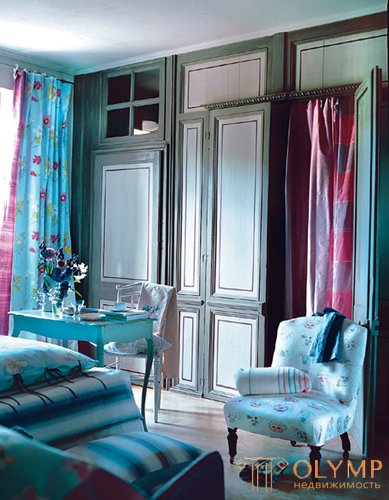
The Mediterranean style is, first of all, “that”, which is connected with the sea, the sun and abundant vegetation. This is a state of peace and tranquility.
Mediterranean style is close to anyone who has ever been to European warm countries and is familiar with the romantic atmosphere. Congestion and pathos are alien to the Mediterranean style. The interiors in the Mediterranean spirit are built on the relaxed combination of antique marble elements with ceramics, wrought-iron furniture and painted wood in bright open colors. The atmosphere is completed by typical fruit motifs, a blue and white cell in textiles and décor with a nautical theme. The main distribution of the Mediterranean style was in the resort and port cities of Italy, Greece, Spain, and Turkey.
Primary colors: muted "colors of the earth", white, grayish-black, shades of the earth and blue.
No luxury - simplicity and practicality. Mediterranean-style interiors reflect the proximity of residents to the sea and the lush vegetation of the coast; they have a lot of wood, cotton, ceramics and other natural materials
The style has a lot in common with English country music, so it remarkably takes root in an old building, and in any private modern house.
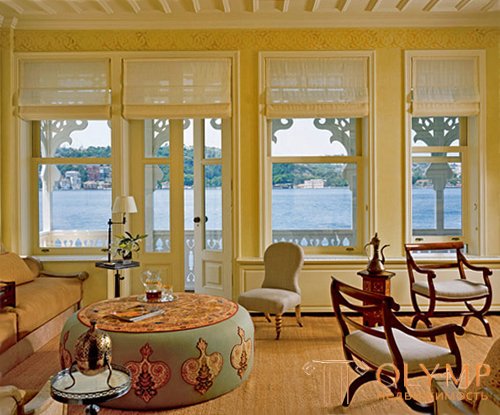
Mediterranean style in the interior, photo
Key features
Historically and geographically, the Mediterranean style was formed from the cultures of countries located on the Mediterranean Sea: Greece, Turkey, Tunisia, Algeria, northern Egypt and Morocco, the Italian and French Riviera, Spain and others. Undoubtedly, all these countries have contributed to the formation of this style and thus weaving a colorful carpet called the Mediterranean style, but the most recognizable image was created by Greece and Italy.
The history of the Mediterranean style as a separate, independent fashion trend has a little more than fifty years. Unlike all other modern trends in interior art, born as a result of numerous “mutations” of earlier, epochal styles, the Mediterranean approach to interior design appeared completely independently, taking as a basis the lifestyle of the indigenous population of Mediterranean countries, primarily its architecture, painting and attributes of everyday home life. In general, this style is very similar to country music, so it will perfectly take root in a historic building, and in any private modern house.
Experts identify several areas within the Mediterranean style. There are no fundamental differences between them, as a rule, it all comes down to small, traditional features of the architecture and interior design of a particular state.
The most vivid and popular, known today far beyond Europe, are considered to be Greek and Italian styles. They appeared almost simultaneously, immediately after the end of the Second World War, and they had nothing to do with classicism, which drew its ideas from the architecture and painting of ancient times.
The predecessor of the Italian version of the Mediterranean style was the so-called Tuscan style of architecture, which appeared in the late forties of the last century in the province of Tuscany, located in the central part of Italy. At that time, Italian cities grew rapidly, and the surrounding villages, gradually turning into a suburb, became empty. As a result, abandoned, but good-quality houses of Tuscan peasants began to inhabit the townspeople. And settling in the village dwellings, they adopted many details of life and interior art.
The main idea of the Mediterranean style in the interior is the archaic simplicity. Practical comfort is created by improvised means with a share of ingenuity, love for creativity and traditions.

Mediterranean style in the interior, photo
The furniture with charm of handwork will ideally fit into an interior of this style. Squat furniture of pine or stained oak warm shades. Actively used painted wood in the color range of this style. In Italian homes popular furniture with forged or lacquered steel frame, legs. In combination with iron, elements of wood, textile, wicker of rattan or reed are actively used, on the tables there is a tabletop made of tiles or marble.
A characteristic feature of Mediterranean interiors are open shelves, similar to shelves in bakeries. Hand-painted ceramics with bright yellow and yellow green lemons, cobalt blue and purple grape branches on the sides are demonstratively arranged on such shelves. Such demonstrativeness is equally characteristic of both Greek and Italian interiors.
In the room, decorated in Mediterranean style, chairs with wicker reed seats will look very organically - both as a set for the dining table, and one by one. A special colorful charm will add to the interior a coffee table or console table with a tabletop made of tiles - it will bring additional bright reflections of light to the room.
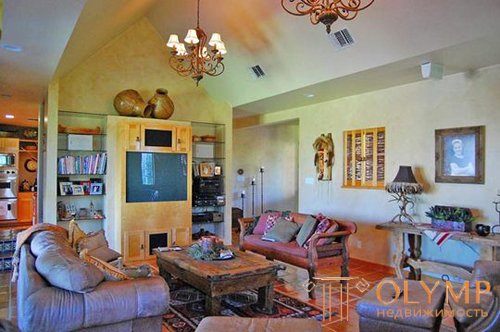
Mediterranean style in the interior, photo
Color solution. In the Greek interior - preference is given to cold colors. These are white, lemon yellow, sunny yellow, all shades of blue (from blue to saturated blue), blue-green, blue-green, emerald green. And as an accent saturated red-pink.
The Italian range is replete with warm shades. It is cream, ocher yellow, deep sunny yellow, ocher, terracotta, brick, olive, bottle green.
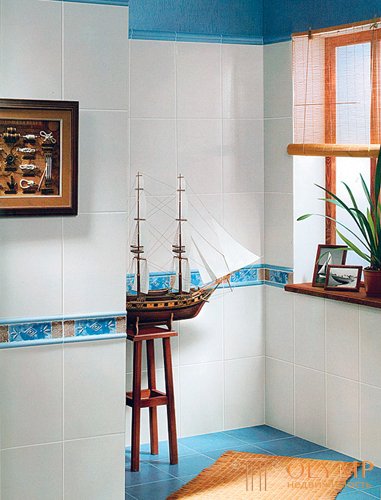
Mediterranean style in the interior, photo
Walls and ceiling. First of all, it is matte, textured surface with the effect of man-made. In the “Italian house” several textures on one wall can be combined at the same time: mosaic tiles, decorative plaster, wall paintings (painting) imitation of frescoes. Mosaic “terrazzo” tiles laid out in the form of a graceful panel on the wall (base or apron) can smoothly pass to the floor.
When painting walls, you can use the technique of applying paint in several layers related colors in the color spectrum. For example, golden ocher and terracotta. This will complicate the perception of the room, make it more interesting and create the effect of the game of sunlight.
In the "Greek" interior base - white walls. Wooden panels, painted in a certain way like the wind, the sun and the sea tested the coating for durability - will bring the charm of the “Greek” Mediterranean.
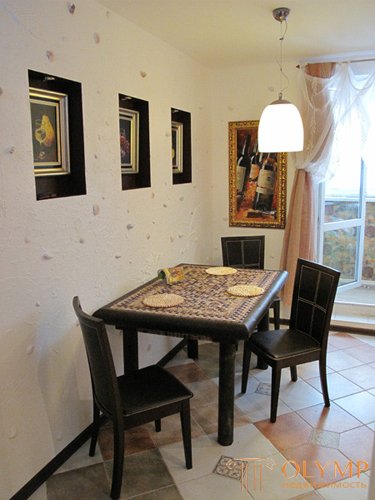
Mediterranean style in the interior, photo
Rough textured plaster will add rustic simplicity to your interior and create the necessary man-made charm. If you have uneven walls, then in this case it will be a plus and will allow to save a little time, effort and finances.
It is appropriate to use bricks, but in small quantities, for a fireplace or a wall around the kitchen.
Cute and stylish looking lined table top kitchen and apron, a single tile of a small format. Ceramic tiles with jagged edges or hand-painted will be the “highlight” of your kitchen.
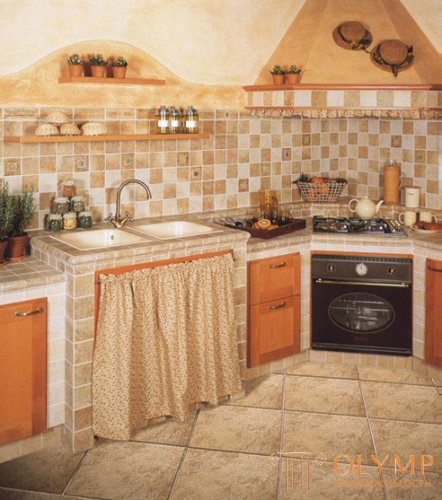
Mediterranean style in the interior, photo
The floors. When constructing a Mediterranean-style floor, it is advisable to use a minimum amount of flooring. It happened so historically in this style, and at the same time you will have the visual integrity of the room.
The tile is a favorite material, unglazed in warm terracotta colors and not only. Imitation tiles, decorative frieze or panel - everything will be appropriate when creating the interior. Marble mosaic with elements of Mediterranean decor will be a stylistic accent on your floor.

Mediterranean style in the interior, photo
Mats made of reed, sisal or seaweed are durable and are also very popular in the premises of this style. They bring a special mood to the interior: proximity to nature, peace and tranquility.
Wooden floors are permissible to use, but with great care and virtuosity. The texture of the wood on the floor should not be too active and dominate over the other elements of the interior.
Textiles and accessories. In the Mediterranean interior, the use of textiles has a more utilitarian than aesthetic purpose. Fabrics of natural origin flax, cotton are used on pillows, bedspreads, mattresses.
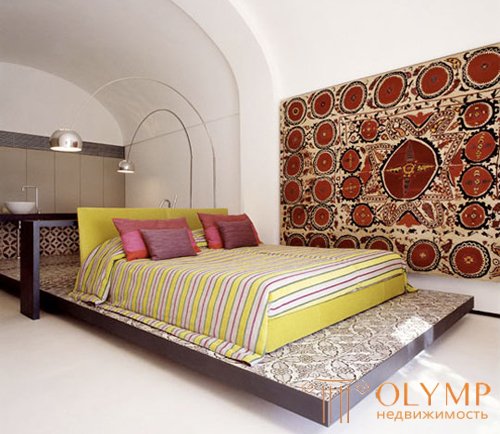
Mediterranean style in the interior, photo
Curtains are very rare, as they are historically used outdoor shutters or awnings. In our case, you can use blinds made of natural materials (matting, bamboo, wood) or Roman curtains made of natural fabrics.
This style does not abound in an ornamental style. Everything is very calm and functional. Handmade lace, crocheted or embroidered with chain stitch. Pure white for the “Greek” version, cream or ivory - for the “Italian”. Lace is usually used as pillowcases and capes on pillows, tablecloths or walkways on sideboards and dressers. Remember, the basic idea of style is accessibility and utility, so there should not be deliberate luxury and chic.
As for accessories, they also obey the above principle. On the open shelves, place - hand-painted, ceramics with vegetable themes. In the same color palette, which is inherent in your interior. Decorating with sea shells, shells, pebbles will create a feeling of proximity to the sea. A large amount of vegetation (preferably in the Mediterranean region) will bring in a feeling of abundance of a lush garden and thereby create the right mood.

Mediterranean style in the interior, photo
Mediterranean style - the style of the sea and the sun.
The Mediterranean style has a variety of interpretations depending on the national color, and may have elements of the interior of France or Morocco, the rest of the Mediterranean countries.
But the basic idea: “The sea, the sun, abundant vegetation, the state of siesta - all this splendor is created by improvised means” is the same for all interpretations.
Mediterranean style is suitable for you if you:
Что бы оставить комментарий войдите
Комментарии (0)